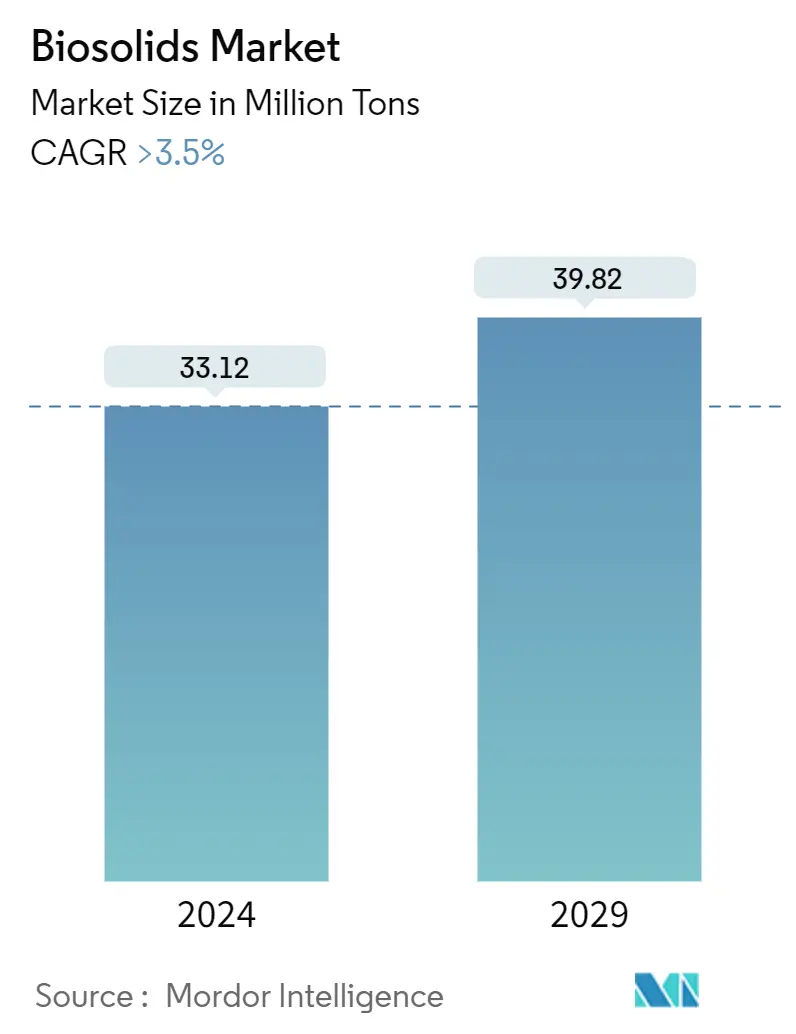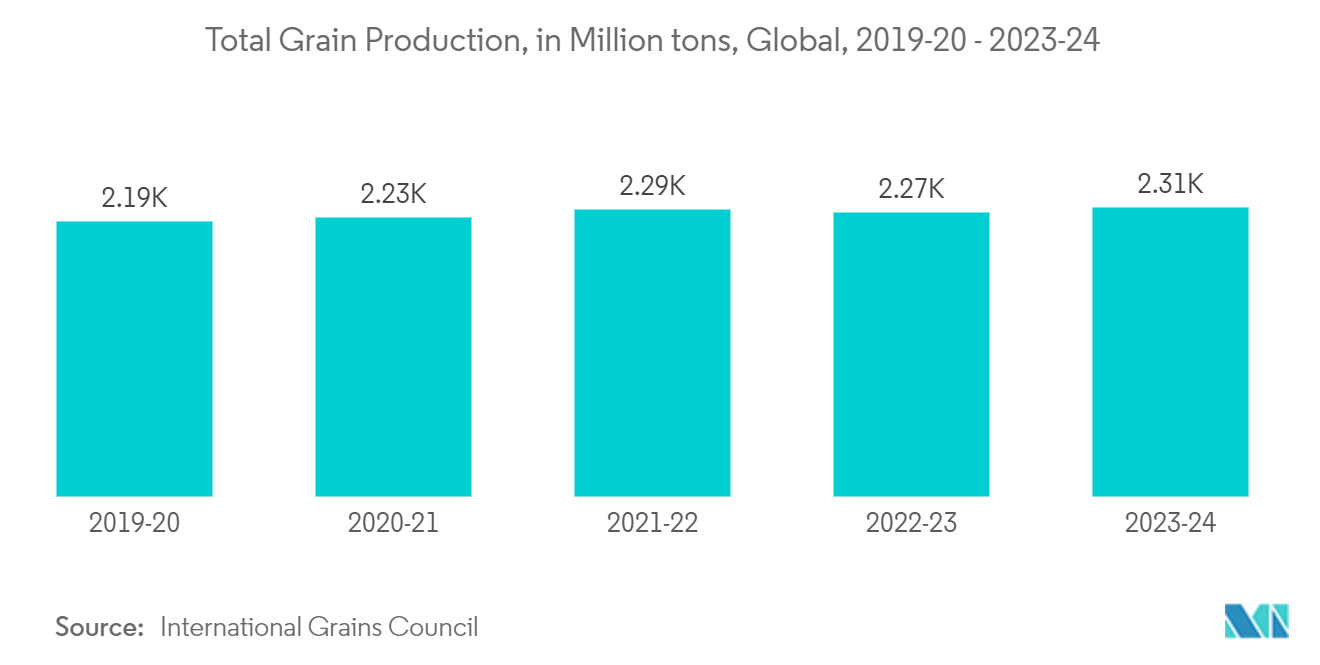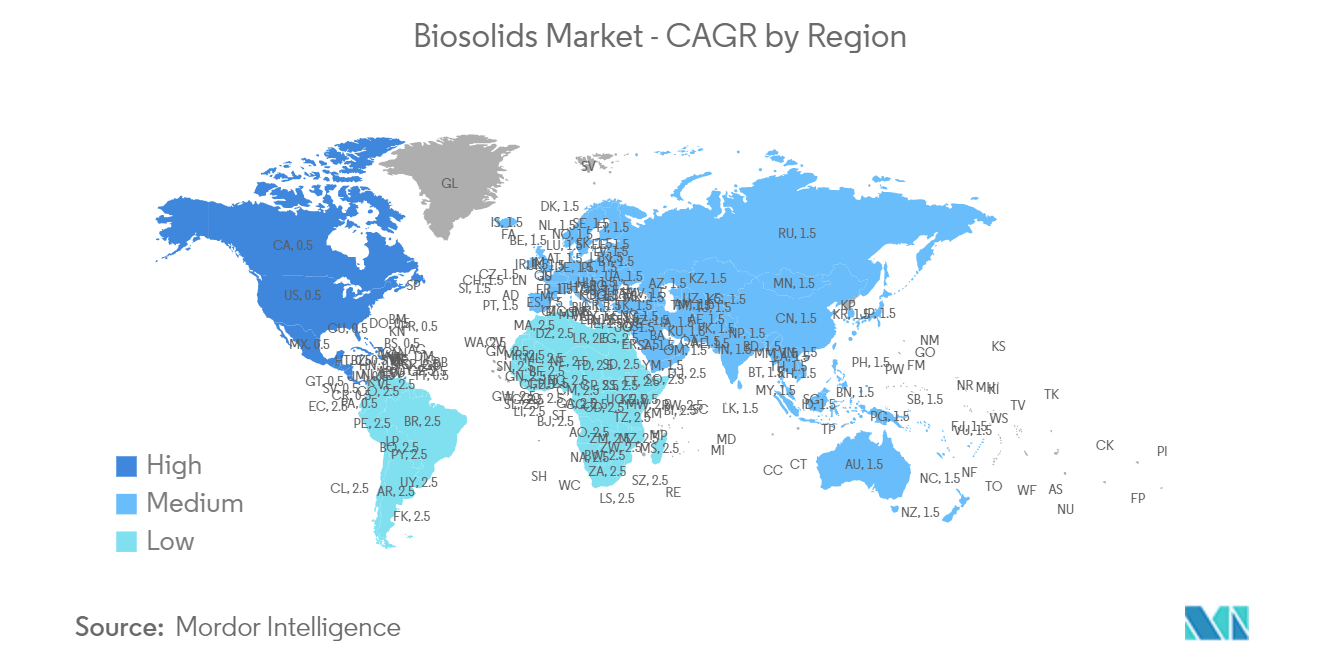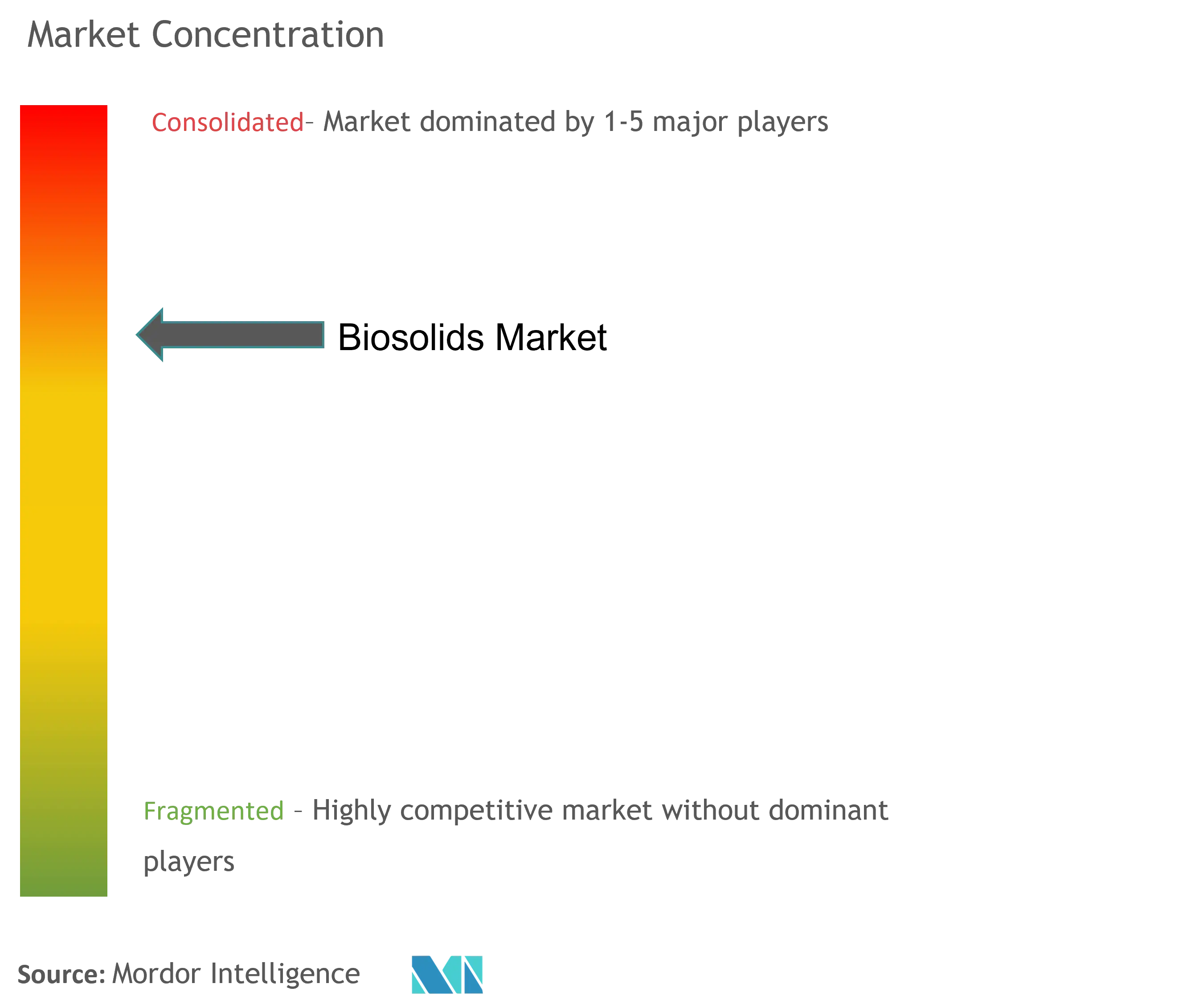Biosolids Market Size

| Study Period | 2019 - 2029 |
| Market Volume (2024) | 33.12 Million tons |
| Market Volume (2029) | 39.82 Million tons |
| CAGR (2024 - 2029) | > 3.50 % |
| Fastest Growing Market | Asia-Pacific |
| Largest Market | North America |
Major Players
*Disclaimer: Major Players sorted in no particular order |
Need a report that reflects how COVID-19 has impacted this market and its growth?
Biosolids Market Analysis
The Biosolids Market size is estimated at 33.12 Million tons in 2024, and is expected to reach 39.82 Million tons by 2029, growing at a CAGR of greater than 3.5% during the forecast period (2024-2029).
The COVID-19 pandemic negatively affected the biosolids market in 2020. However, the growing demand for biosolids on agricultural land has fueled overall industry growth since the pandemic.
- One of the main things driving the market that was looked at is the need to replace dangerous chemical fertilizers and strict emission laws in many countries around the world.
- On the other hand, contradictory information about biosolids that is available to the public is expected to slow the growth of the market studied.
- The rising focus on sludge treatment in the Asia-Pacific, mainly in China and India, is anticipated to offer new avenues for industry growth shortly.
- North America dominated the biosolids market due to government and public support for environmental-friendly technologies.
Biosolids Market Trends
Agricultural Land Application to Dominate the Market
- Biosolids can be used on agricultural land, in forests, on rangelands, or in disturbed land needing reclamation.
- In terms of consumption, agricultural land applications consume the most biosolids. Consistent population growth across Asia-Pacific and North America is expected to augment the need for agricultural yields, which may positively affect the consumption of biosolids in the sector.
- According to the International Grains Council, in FY 2021-2022, the total grain production globally was about 2,294 million metric tons, about 3.05% more than the previous year. Furthermore, as per the council's estimation in FY 2022-2023, the total global grain production will decrease to 2,267 million metric tons. However, it is anticipated to reach 2,310 in FY 2023-2024.
- China accounts for about 7% of the overall crop production globally, thus feeding 22% of the world’s population. The country is the largest producer of different crops, including rice, cotton, potatoes, and other crops.
- According to the Third Advance Estimates for crop production by the Ministry of Agriculture and Farmers Welfare, total foodgrain production in the country in 2022-23 was valued at 330.5 million tonnes (MT) from 315.6 MT.
- Scientists and farmers are looking for new technologies to increase the productivity of crops and meet the food demand arising from disproportionate population growth. In addition, there has been a decrease in the total available cropland area in countries such as the United States over the last decade.
- Biosolids can be effectively used as fertilizers and soil conditioners for human crop production. These are usually incorporated into the soil with conventional farm equipment. They are also used as fertilizer for animal crop production.
- Big enterprises and farmers are increasingly making their presence felt in cattle farming and meat products. They are augmenting the demand for animal crop production, which is providing impetus to the application of biosolids as fertilizers for animal crop production. This has led to an increase in demand for biosolids in agricultural land applications.
- They also help reduce fertilizer costs and provide many micronutrients for crop growth. The increasing world population is expected to give rise to a growing need for agriculture, which may impact the use of biosolids in the sector.
- Hence, agricultural land application is expected to dominate the market studied during the forecast period.

North America to Dominate the Market
- North America dominated the market owing to the government and public support for environmental-friendly technologies in countries such as the United States and Canada.
- In the United States, the biosolids market is mostly driven by the fact that both the government and the public want to use technologies that are good for the environment.
- The US EPA adopted the name "biosolids" to differentiate high-quality treated sewage sludge from raw sewage sludge, which contains large amounts of pollutants.
- There are two ways to get rid of biosolids from wastewater that cannot be used again (like putting them in a landfill) and ways to use them in a good way (like landfilling with biogas and energy recovery).
- Biosolids are generated during wastewater treatment processes and are extensively used to satisfy the US EPA's 40 CFR Part 503 regulations.
- The majority of the biosolids that are currently generated in the country are expected to be EQ or PC biosolids containing low levels of pollutants. About half of the biosolids produced in the country are being beneficially used to improve soils.
- In the United States, biosolids are either recycled or applied as fertilizer to improve and maintain productive soils and stimulate plant growth. By treating sewage sludge, the biosolids are used as valuable fertilizer instead of taking up space in a landfill or other disposal facility. Approximately half of all biosolids are recycled to land.
- The demand for food is growing rapidly with the rising population in the United States. In 2022, the average household spending in the United States on food increased by about 12.72% and was valued at USD 9,343.
- The rising agriculture sector is expected to further boost the consumption of biosolids. Agriculture and related industries contributed to about 5.5% of the US gross domestic product (GDP) in 2022.
- Therefore, due to the above factors, North America is anticipated to have the largest market share during the forecast period.

Biosolids Market Industry Overview
The biosolids market is partially consolidated in nature. The major players (not in any particular order) include REMONDIS SE & Co. KG, Cambi ASA, FCC Group, Englobe, and Cleanaway, among others.
Biosolids Market Leaders
REMONDIS SE & Co. KG
Cambi ASA
FCC Group
Englobe
Cleanaway
*Disclaimer: Major Players sorted in no particular order

Biosolids Market News
- January 2023: Synagro Technologies Inc., a provider of biosolids and residual solutions, acquired Burch Hydro Inc., an Ohio-based premier provider of biosolids and lime-residuals management and land application.
- November 2022: The San Francisco Public Utilities Commission (SFPUC) and Cambi announced an agreement for the installation of three thermal hydrolysis systems as part of the Biosolids Digester Facilities Project at the Southeast Treatment Plant in San Francisco. The SFPUC is investing over USD 3 billion to upgrade and modernize the Southeast Treatment Plant, the city's largest wastewater treatment facility. This project is part of a more extensive citywide Sewer System Improvement Program.
Biosolids Market Report - Table of Contents
1. INTRODUCTION
1.1 Study Assumptions
1.2 Scope of the Study
2. RESEARCH METHODOLOGY
3. EXECUTIVE SUMMARY
4. MARKET DYNAMICS
4.1 Drivers
4.1.1 Replacing Hazardous Chemical Fertilizers in North America
4.1.2 Stringent Government Emission Laws
4.1.3 Other Drivers
4.2 Restraints
4.2.1 Lack of Proper Knowledge and Awareness on Biosolids
4.2.2 Other Restraints
4.3 Industry Value Chain Analysis
4.4 Porter's Five Forces Analysis
4.4.1 Bargaining Power of Suppliers
4.4.2 Bargaining Power of Consumers
4.4.3 Threat of New Entrants
4.4.4 Threat of Substitute Products and Services
4.4.5 Degree of Competition
5. MARKET SEGMENTATION (Market Size in Volume)
5.1 Type
5.1.1 Class A
5.1.2 Class A EQ (Exceptional Quality)
5.1.3 Class B
5.2 Form
5.2.1 Cakes
5.2.2 Liquid
5.2.3 Pellet
5.3 Application
5.3.1 Agriculture land Application
5.3.1.1 Fertilizer/Soil Conditioner for Human Crop Production
5.3.1.2 Fertilizer for Animal Crop Production - Pastures
5.3.2 Non-agricultural Land Application
5.3.2.1 Forest Crops (Land Restoration and Forestry)
5.3.2.2 Land Reclamation (Roads and Urban Wetlands)
5.3.2.3 Reclaiming Mining Sites
5.3.2.4 Landscaping, Recreational Fields, and Domestic Use
5.3.3 Energy Recovery Energy Production
5.3.3.1 Heat Generation, Incineration, and Gasification
5.3.3.2 Oil and Cement Production
5.3.3.3 Commercial Uses
5.4 Geography
5.4.1 Asia-Pacific
5.4.1.1 China
5.4.1.2 India
5.4.1.3 Japan
5.4.1.4 South Korea
5.4.1.5 Malaysia
5.4.1.6 Thailand
5.4.1.7 Indonesia
5.4.1.8 Vietnam
5.4.1.9 Rest of Asia-Pacific
5.4.2 North America
5.4.2.1 United States
5.4.2.2 Canada
5.4.2.3 Mexico
5.4.3 Europe
5.4.3.1 Germany
5.4.3.2 United Kingdom
5.4.3.3 Italy
5.4.3.4 France
5.4.3.5 Spain
5.4.3.6 NORDIC
5.4.3.7 Turkey
5.4.3.8 Russia
5.4.3.9 Rest of Europe
5.4.4 South America
5.4.4.1 Brazil
5.4.4.2 Argentina
5.4.4.3 Colombia
5.4.4.4 Rest of South America
5.4.5 Middle East and Africa
5.4.5.1 Saudi Arabia
5.4.5.2 South Africa
5.4.5.3 Nigeria
5.4.5.4 Qatar
5.4.5.5 Egypt
5.4.5.6 United Arab Emirates
5.4.5.7 Rest of Middle East and Africa
6. COMPETITIVE LANDSCAPE
6.1 Mergers and Acquisitions, Joint Ventures, Collaborations, and Agreements
6.2 Market Share Analysis
6.3 Strategies Adopted by Leading Players
6.4 Company Profiles
6.4.1 Agrivert Ltd
6.4.2 Aguas Andinas SA
6.4.3 Alan Srl
6.4.4 Allevi Srl
6.4.5 BCR Environmental
6.4.6 C.R.E. - Centro di Ricerche Ecologiche
6.4.7 Cambi ASA
6.4.8 Casella Waste Systems Inc.
6.4.9 Cleanaway
6.4.10 DC Water
6.4.11 Eco-trass
6.4.12 Englobe
6.4.13 FCC Group
6.4.14 Lystek International
6.4.15 Merrell Bros. Inc.
6.4.16 Parker Ag Services LLC
6.4.17 Recyc Systems Inc.
6.4.18 REMONDIS SE & Co. KG
6.4.19 Saur
6.4.20 SYLVIS
6.4.21 Synagro Technologies
6.4.22 Terrapure BR Ltd
6.4.23 Walker Industries
- *List Not Exhaustive
7. MARKET OPPORTUNITIES AND FUTURE TRENDS
7.1 Increasing Focus on Sludge Treatment in Asia-Pacific
7.2 Other Opportunities
Biosolids Industry Segmentation
Biosolids are organic materials rich in nutrients. They are produced by the treatment of domestic sewage in a wastewater treatment facility. They are a vital resource as they contain essential plant nutrients and organic matter, and they are recycled as fertilizer and soil amendment.
The biosolids market is segmented by type, form, application, and geography. By type, the market is segmented into Class A, Class A EQ, and Class B. By form, the market is segmented into cakes, liquids, and pellets. By application, the market is segmented into agriculture land application, non-agriculture land application, and energy recovery energy production. The report also covers the market sizes and forecasts for the biosolids market in 27 countries across the major regions. Market sizing and forecasting for each segment have been done based on volume (tons).
| Type | |
| Class A | |
| Class A EQ (Exceptional Quality) | |
| Class B |
| Form | |
| Cakes | |
| Liquid | |
| Pellet |
| Application | ||||||
| ||||||
| ||||||
|
| Geography | |||||||||||
| |||||||||||
| |||||||||||
| |||||||||||
| |||||||||||
|
Biosolids Market Research FAQs
How big is the Biosolids Market?
The Biosolids Market size is expected to reach 33.12 million tons in 2024 and grow at a CAGR of greater than 3.5% to reach 39.82 million tons by 2029.
What is the current Biosolids Market size?
In 2024, the Biosolids Market size is expected to reach 33.12 million tons.
Who are the key players in Biosolids Market?
REMONDIS SE & Co. KG, Cambi ASA, FCC Group, Englobe and Cleanaway are the major companies operating in the Biosolids Market.
Which is the fastest growing region in Biosolids Market?
Asia-Pacific is estimated to grow at the highest CAGR over the forecast period (2024-2029).
Which region has the biggest share in Biosolids Market?
In 2024, the North America accounts for the largest market share in Biosolids Market.
What years does this Biosolids Market cover, and what was the market size in 2023?
In 2023, the Biosolids Market size was estimated at 31.96 million tons. The report covers the Biosolids Market historical market size for years: 2019, 2020, 2021, 2022 and 2023. The report also forecasts the Biosolids Market size for years: 2024, 2025, 2026, 2027, 2028 and 2029.
Biosolids Industry Report
Statistics for the 2024 Biosolids market share, size and revenue growth rate, created by Mordor Intelligence™ Industry Reports. Biosolids analysis includes a market forecast outlook to 2029 and historical overview. Get a sample of this industry analysis as a free report PDF download.
